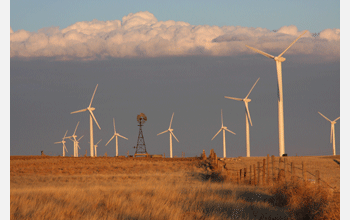Multimedia Gallery
Wind Turbine Farm
This image contrasts the past--a wind pump used to draw water from farm wells for cattle, and the future--modern wind turbines. Both are examples of environmentally sustainable technology. The wind turbines are part of the Cedar Creek wind farm east of Grover, Colo. Completed in 2007, Cedar Creek includes more than 250 turbines and generates roughly 300 megawatts of energy. As wind energy grows in importance, scientists at the National Center for Atmospheric Research (NCAR) are studying how wind turbines and farms interact with the atmosphere, and how their output can be better predicted and managed.
Located in Boulder, Colo., and funded by the National Science Foundation, NCAR is a focal point for research in the field of atmospheric sciences. NCAR has about 750 scientists and support personnel and provides the university science and teaching community with the tools, facilities and support required to perform innovative research. Through NCAR, scientists gain access to high-performance computational and observational facilities, such as supercomputers, aircraft and radar--resources researchers need to improve human understanding of atmospheric and Earth system processes. NCAR and university scientists work together on research topics in atmospheric chemistry, climate, cloud physics and storms, weather hazards to aviation, and interactions between the sun and Earth. In all of these areas, scientists are looking closely at the role of humans in both creating climate change and responding to severe weather occurrences.
NCAR is managed under a cooperative agreement between the Foundation and the University Corporation for Atmospheric Research (UCAR), a nonprofit consortium of 68 North American universities with graduate programs in atmospheric sciences. For more information about NCAR, visit the facility's website. (Date of Image: unknown)
Credit: ©University Corporation for Atmospheric Research
See other images like this on your iPhone or iPad download NSF Science Zone on the Apple App Store.
Images and other media in the National Science Foundation Multimedia Gallery are available for use in print and electronic material by NSF employees, members of the media, university staff, teachers and the general public. All media in the gallery are intended for personal, educational and nonprofit/non-commercial use only.
Images credited to the National Science Foundation, a federal agency, are in the public domain. The images were created by employees of the United States Government as part of their official duties or prepared by contractors as "works for hire" for NSF. You may freely use NSF-credited images and, at your discretion, credit NSF with a "Courtesy: National Science Foundation" notation.
Additional information about general usage can be found in Conditions.
Also Available:
Download the high-resolution JPG version of the image. (6.6 MB)
Use your mouse to right-click (Mac users may need to Ctrl-click) the link above and choose the option that will save the file or target to your computer.

